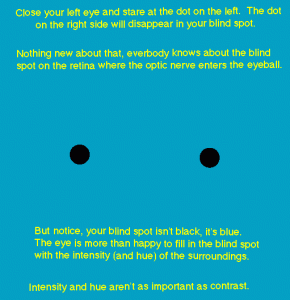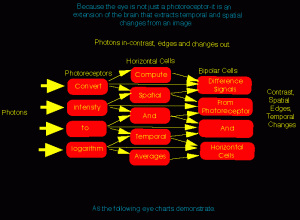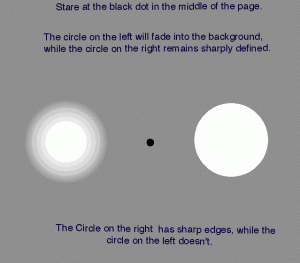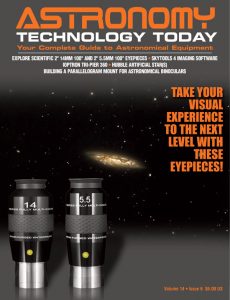
Rigel Systems recently introduced the PulsGuide Jr ($39.95US), a shorter (by 1/2 inch) version of its popular PulsGuide guiding telescope eyepiece illuminator for finders.
Both illuminators are designed to attach onto the illuminator port of an eyepiece equipped with crosshair or micrometer reticle. These eyepieces are used for guiding during astrophotography sessions, for measuring angular separations, or in finderscopes. The illuminator will illuminate only the reticle or micrometer of the eyepiece so that its pattern may readily be seen in faint red, contrasting against the night sky background. . On and off times and the reticle brightness are all variable and the unit is compatible with many existing guiding eyepieces.
Like the original PulsGuide, the junior version eyepiece illuminator fits all current finder eyepieces using an M8-by-1.0 thread, which pretty much covers everything these days. For those of you who have an older finder that uses an M8-by-0.75 thread, Rigel System will provide that on special order.
The PulsGuide Jr also differs from the original PulsGuide in how it is controlled. The original features two knobs, while the Jr version simplifies things with just one for control of timing and brightness. But why does pulsing reticle illumination matter? We’ll let Rigel Systems’ Leon Palmer explain the physiology.

“The big deal is designing the reticle illumination to complement how the eye works. Red light, of course, to preserve night vision. Pulsing, to keep the eye from going blank, because the eye – the retina – is more than just billions of light sensors converting photons into electrical signals to send on to the brain for processing. If the retina merely converted photons to electrons, it would require an optic nerve an inch across!
So, something must happen in the retina itself. The retina processes the image to extract the most important information and sends that to the brain. So, what is the most important thing your retinas see? Well, put yourself into an eat-or-be-eaten state of mind. If your sitting in the jungle, what is the most important thing in the environment that your retinas need to tell your brain about? Is it the tiger sneaking up on you, or the bush sitting next to you? How do your retinas tell the two apart? Tigers move, and bushes don’t. It is that motion – that change in the image on your retinas – that retinas extract and send on to the brain. Intensity and hue are secondary and can be

filled in later. As you can see in Figure 1.
So how does the retina process information? Doesn’t that take Neurons? Brains? Yes, and that’s exactly what the retina is, an approachable part of the brain (ref: John E. Dowling “The Retina an Approachable Part of the Brain,” 1987, ISBN 0-674-76680-6). The retina is a mesh of neurons and photoreceptors, wired and programed to extract change from the image on the retina (Figure 2).
Indeed, this is one part of the brain that we do know pretty well how it works. We know how it works so well – how the retina extracts motion, edges, contrast – that scientists have built it in silicon (Ref: Carver Mead, “Silicon Retinas.” To illustrate this, try out the eye charts in Figures

3 and 4.
If intensity and hue were more important than change in the image (contrast in this case) then the ring would not look brighter on one side than the other. Edges are important too. To give an example of how important edges are, think why should a pencil sketch – a line drawing – of someone’s face be recognizable as a face? After all, it’s just lines. But those lines are the edges of the facial features. A line sketch simplifies things down the same way the retina does. To the basic important features your brain is designed to make sense of … edges! Which leads to Figure 4.
The chart in Figure 4 is sorta neat. Stare long enough and the fuzzy edged circle goes to gray. If

you could keep your eyes completely still (notice how hard it is to keep them still the longer you stare), then even the sharp-edged circle will grey out. Fortunately, your eyes won’t let you. They constantly jitter just a little bit to keep sharp edges detectable by the retina’s processing. Which brings us back to why PulsGuide works.
The longer and harder you stare at a guide star hiding behind a constantly illuminated crosshair, the more you try to keep your eye from jittering, the worse you’ll do because it’s completely contrary to how your retina works. PulsGuide, by blinking the crosshair, introduces change in the image. PulsGuide works with your retinas to keep your vision at maximum sensitivity. As a result, you can work with fainter guide stars, guide more comfortably, and get better astrophotographs.”
 And to make it easier for you to get the most extensive telescope and amateur astronomy related news, articles and reviews that are only available in the magazine pages of Astronomy Technology Today, we are offering a 1 year subscription for only $6! Or, for an even better deal, we are offering 2 years for only $9. Click here to get these deals which only will be available for a very limited time. You can also check out a free sample issue here.
And to make it easier for you to get the most extensive telescope and amateur astronomy related news, articles and reviews that are only available in the magazine pages of Astronomy Technology Today, we are offering a 1 year subscription for only $6! Or, for an even better deal, we are offering 2 years for only $9. Click here to get these deals which only will be available for a very limited time. You can also check out a free sample issue here.



